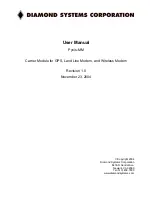
©Copyright Task Force Tips LLC 2011-2019
LIG-012 March 28, 2019 Rev06
21
6.0 USE WITH FOAM
The G-Force nozzle may be used with foam solutions. Refer to fi re service training for the proper use of foam.
WARNING
For Class B fi res, lack of foam or interruption in the foam stream can cause a break in the foam
blanket and greatly increase the risk of injury or death. Assure that:
• Application rate is suffi
cient (see NFPA 11 or foam manufacturer’s recommendations)
• Enough concentrate is on hand to complete task (see NFPA for minimum duration time
requirements)
• Foam logistics have been carefully planned.
Allow for such things as:
• Storage of foam in a location not exposed to the hazard it protects
• Personnel, equipment and technique to deliver foam at a rapid enough rate
• Removal of empty foam containers
• Clear path to deliver foam, as hoses and other equipment and vehicles are deployed
WARNING
Improper use of foam can result in injury or damage to the environment. Follow foam
manufacturer’s instructions and fi re service training to avoid:
• Using wrong type of foam on a fi re. i.e. Class A foam on a Class B fi re.
• Plunging foam into pools of burning liquid fi res.
• Causing environmental damage.
• Directing stream at personnel.
WARNING
There are a wide variety of foam concentrates. Each user is responsible for verifying that any
foam concentrate chosen to be used with this unit has been tested to assure that the foam
obtained is suitable for the purpose intended.
WARNING
Use of compressed air foam (CAF) with hand held nozzles can cause sudden surges in nozzle
reaction force resulting in risk of injury or death from loss of footing or hose whipping. Be
prepared for sudden changes in nozzle reaction caused by:
• Slug loading (Loss of foam concentrate sends slugs of air and water into the nozzle)
• Sudden release of built-up pressure in the hose when opening a nozzle
6.1 FOAM ASPIRATING ATTACHMENTS
To increase the expansion ratio, G-Force Series MX Foamjet multi-expansion attachment or LX Foamjet low expansion attachment
may be used with G-Force nozzles. (See table below for FoamJet model numbers) These foam tubes attach and detach quickly from
the nozzle. Note: As expansion ratio is increased, the reach of the nozzle will be decreased due to the greater amount of bubbles
in the stream and their ability to penetrate the air. Generally the reach with foam is approximately 10% less than with water only.
Actual results will vary based on brand of foam, hardness of water, temperature, etc. See Foamjet instruction manual for specifi c
information. See LIA-025 (MANUAL: Foam Attachments for TFT Nozzles).
FOAMJET
MODEL NUMBER
1.5” / 38mm G-Force MX
FJ-MX-G
1.5” / 38mm G-Force LX
FJ-LX-G
1.0” / 25mm G-Force MX
FJ-UMX
1.0” / 25mm G-Force LX Long
FJ-LX-U
1.0” / 25mm G-Force LX Short
FJ-GD
7.0 USE OF NOZZLES
IT IS THE RESPONSIBILITY OF THE INDIVIDUAL FIRE DEPARTMENT OR AGENCY TO DETERMINE PHYSICAL CAPABILITIES
AND SUITABILITY FOR AN INDIVIDUAL’S USE OF THIS EQUIPMENT.
Many factors contribute to the extinguishment of a fi re. Among the most important is delivering water at a fl ow rate suffi cient to absorb
heat faster than it is being generated. The fl ow rate depends largely on the pump discharge pressure and hose friction loss. It can be
calculated using a hydraulic equation such as:
PDP = NP+FL+DL+EL
PDP
= Pump discharge pressure
NP
= Nozzle pressure
FL
= Hose friction loss
DL
= Device loss
EL
= Elevation loss
Note:
The same unit of pressure must be used for
every pressure in the equation , eg. psi, bar, kPa
This Safety Manual is not intended as a substitute for proper training in the use of rescue systems as taught from credible
sources such as the National fi re Protection Association (NFPA), The International Fire Service Training Association
(IFSTA), or sources approved by the Authority Having Jurisdiction (AHJ).















































